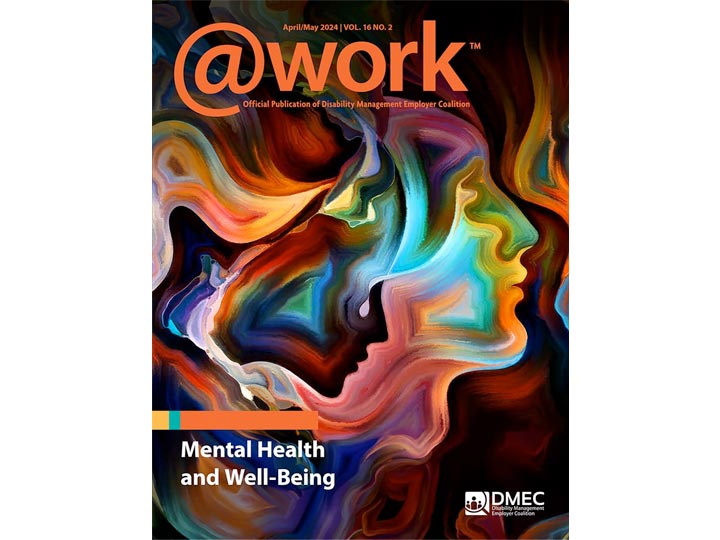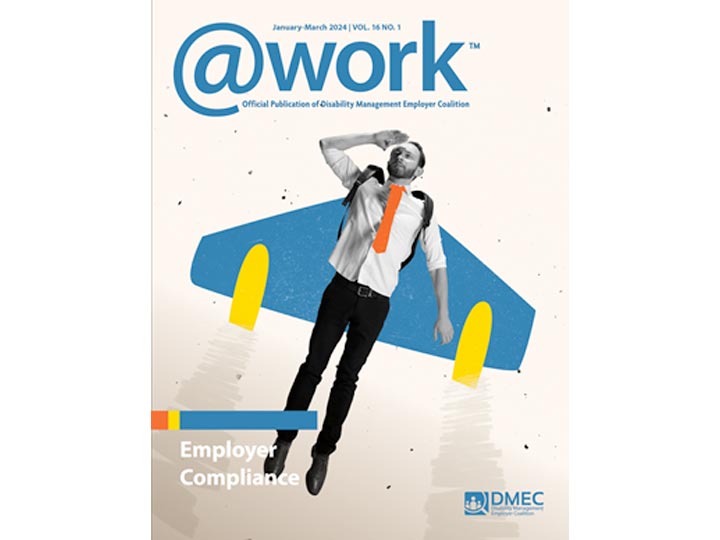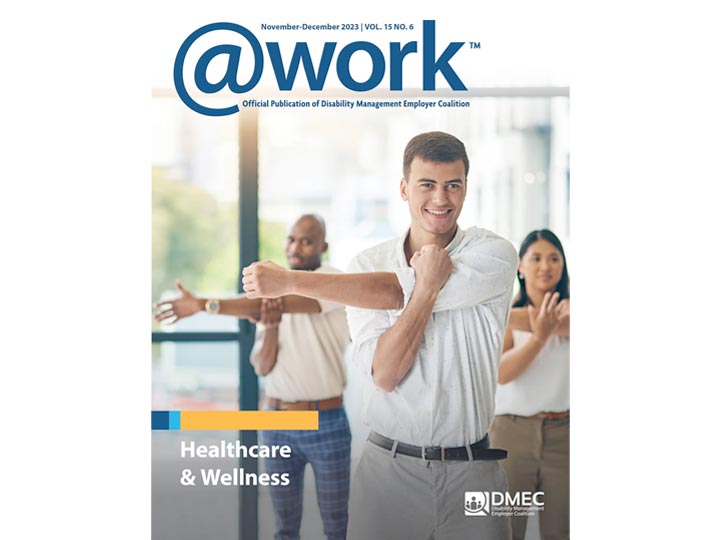Expert’s 4-step process for managing employees with psychological disabilities
When it comes to accommodating psychological disabilities, most employers will agree few situations are more challenging. With no one-size-fits-all answer, solutions are always employee specific, making psychological disabilities one of the toughest disabilities to manage.
As a result, Rachel Shaw, principal consultant of Shaw HRC Consulting, is sharing her uniform process that can help alleviate a lot of the headaches and compliance issues when seeking accommodations for employees with these disabilities.
————————————————————-
The National Alliance of Mental Illness reports that one in five adults — or approximately 43.8 million Americans — experience mental illness in any given year. Moreover, one in 25 live with serious mental illnesses that substantially interfere with (or limit) one or more major life activity, such as working. Many employees manage their disabilities without employers ever knowing about them. Employees who are able to self-manage their disabilities, or whose disabilities don’t impact them at work, would not be in need of, or likely to request reasonable accommodations under the Americans with Disabilities Act (ADA). For those that do trigger your organization to act, it’s important to recognize when it happens and respond without delay.
Accommodating psychological disabilities range from minor accommodation requests to addressing concerns of possible imminent danger. The key is not to put your disability program at risk by treating requests or disability types differently. Protect your organization by knowing when you are triggered to start the ADA’s interactive process and by consistently following your defined process steps.
Know Your Triggers, Have a Process
There are three ways an employer is triggered to start a timely, good-faith interactive process,
- Request for Accommodation.
- Perception that an employee has a disability impacting successful or safe performance of their job, and
- Knowledge of the disability as evidenced by a health care provider note.
A request for accommodation can occur when someone in your organization, often a front-line supervisor, receives a verbal or informal request for accommodation. This might be a statement “I’m seriously stressed by work,” “I haven’t been able to eat or sleep in weeks,” or “My doctor told me I can’t tolerate the stressors at work.”
A perception of a disability impacting work is also a trigger to begin the interactive process. This includes if there is a good-faith belief or perception an employee is failing to perform successfully or safely due to a disability. With any process, from discipline to disability accommodations, the process goals are to support successful and safe performance of the job. You also want to be careful you don’t overly perceive persons to be disabled
Note: If there is belief a disability could be impacting performance, it would be inappropriate and illegal (Gambini v. DaVita) to discipline performance related to a perceived or known disability.
Finally, the third trigger, knowledge of a disability, is when an employee presents a note from a medical provider — psychologist, psychiatrist, licensed marriage orfamily therapist, physician’s assistant or other health care provider — stating he or she has a psychological disability.
Once triggered, your obligations under Title I of the Americans with Disabilities Act (ADA/ADAAA) begin. The ADA requires two things of employers to ensure compliance:
- A timely, good-faith interactive process, and
- To provide reasonable accommodations to covered employees.
While being triggered requires the employer to start the interactive process obligation, it does not mean the individual will ultimately be in need of, or eligible for, reasonable accommodations. The process will make it clear if the second obligation is required.
Disability Interactive Process Hallway®
I’ve managed thousands of disability cases related to psychological illness and psychological disabilities. Through these and other types of disability compliance cases, I have developed a protocol to ensure compliance with the ADA disability interactive process obligation. I call it the Disability Interactive Process Hallway.
The process is a metaphorical hallway with four doors, or key process steps, which lead to a compliant decision and best possible outcome for an employee who may or may not need workplace accommodations. Each door serves as a step along the path of ADA compliance:
- Door #1 — Gathering the necessary data
- Door #2 — Research and exploration of accommodation ideas
- Door #3 — Scheduling and holding a reasonable accommodations meeting
- Door #4 — Implement decisions and close the process properly.
The process is the same whether it’s a physical or psychological disability. However, there are some specific tools to employ when dealing with a psychological disability.
Door #1 – Gathering the necessary data
The Hallway always begins at Door # 1. It is at this door you will discover if the employee has a disability impacting their work performance wholly or partially. In the case of a possible psychological disability, it’s important to obtain clarification from a healthcare provider as to how the particular disability may impact an employee in performing the specific job requirements. Conditions may impact an employee’s home life and personal activities, but unless the disability impacts the safe or full performance of his or her job, an employee is not in need of workplace reasonable accommodations.
Many employers feel writing a questionnaire is daunting — especially in the case of psychological disabilities. Remember, you’ll want to create a questionnaire that works to take the initially intangible and whittle it down to a quantifiable, concrete description. For example, don’t be afraid to ask what specific interactions, experiences or workplace factors cause a medically restricted level of “stress.” If the employee has been restricted from working with a certain person, or in a certain area or department, note that this is an accommodation suggestion and not a restriction. You want to seek restrictions and functional limitations and not stop at suggestions or ideas. Ask the healthcare provider what the underlining workplace factors are. What workplace restrictions or limitations is the accommodation seeking to limit or eliminate?
Ask common-sense questions, use common language, and help healthcare providers understand how you interpret their opinions. Be polite but persistent. If you cannot obtain objective and reliable information from the employee’s personal healthcare provider, you may need to use a third-party Fitness for Duty (FFD) Examination to gather this information. Ultimately, it is important you understand clearly, as the employer, what is being requested. If you don’t, keep seeking clarification.
If the employee’s medical provider, indicates the employee does not have a disability that impairs the person from accessing or performing work, then you exit The Hallway, close the process and document your good work. If the provider is able to confirm a disability and clarify how the disability effects specific job requirements, then continue down The Hallway and move to Door # 2.
Door #2 – Research and exploration of accommodation ideas
This is where safe and non-biased conversation about possible accommodation ideas, options and ramifications begin. When managing a case where a psychological disability is involved, this is the place to talk with supervisors and other interactive process participants openly about any legitimate concerns that may have arisen in the discovery process. It is where efforts made by an organization have to be in good faith and offered with sincere hope that the reasonable accommodations will work.
This is where the parties research reasonable accommodations and where both show their “good-faith” efforts. If you don’t try to find a “yes” to accommodation, you will have a hard time proving your organization complied with this obligation.
Door #3 – Scheduling and holding the accommodations meeting
Once Door # 1 and # 2 are completed, and it has been established the restrictions are going to be in place long-term or permanently, the parties will meet for a reasonable accommodations meeting. Scheduling and preparing for this meeting is critical.
First, determine who is to attend, and then send out written notices memorializing all the work done at Doors #1 and #2.
The written notice should include:
- Who will be attending from your organization
- A reminder the employee can bring any representative of their choice
- Listing the medical restrictions that will be utilized during the meeting, and
- Information on the possible outcome so the employee is fully aware what they can expect.
Send the meeting notice at least 10-calendar days before the meeting is to be held, and call to confirm attendance.
At the meeting, take notes. Document the discussion as it occurs and before the parties leave, pass out copies of the drafted meeting notes, and obtain edits and signatures from all.
Taking notes and requesting signatures will be the most important step of this process. It will best protect you by providing a real-time example of the honest and good-faith efforts of your organization to discuss openly options that may or may not exist to support the employee to continue working, or return to work.
Door #4 – Implement decisions and close the process properly
Accommodation plans for those with psychological disabilities often require regular performance monitoring. Be sure to establish rules for monitoring and timelines, and make sure they are executed. Document in the meeting notes and reasonable accommodation agreements what may cause the employer to restart The Hallway and/or what could be used as evidence the accommodation plan was unsuccessful.
If reasonable accommodations were not able to be discovered and implemented to support the employee to continue working in their primary job, Door # 4 will allow the time to process alternative work exploration and/or implement medical retirement or separation proceedings.
Exceptions
There is a short list of psychological disabilities not protected under the ADA. This includes psychological disabilities that limit interactions only with certain supervisors and/or other people; kleptomania; pyromania; compulsive gambling; sexually disordered behavior; and unlawful use of controlled substances or other drugs.
The courts have agreed if an employee exhibits a psychological disability that affects his or her ability to be around a certain person or supervisor, that employee is not entitled to an accommodation that would eliminate the interaction. A transfer or change in supervision is not a reasonable accommodation in these situations. This doesn’t mean the person doesn’t have a disability, only that the courts have determined the accommodation would be an undue burden to the employer, and the disability isn’t substantial, since it doesn’t restrict the person from working in general.
Your organization still engages in The Hallway when employees report a disability of this nature. You must still go through Door #1, and establish the disability and obtain clarification. The Hallway may provide for accommodations such as altering how supervision is given, or putting an end to interactions that are inappropriate or not burdensome to stop all together.
In the end, handling psychological disabilities can seem overwhelming at first, but when addressed quickly, utilizing a uniform process, organizations can be confident a sound decision can be made.
Rachel Shaw is the principal consultant of Shaw HRC Consulting, a Human Resources firm specializing in providing employers with a full range of Disability Compliance Management consulting and training services to support their compliance with federal and state disability and leave laws. Rachel is also the author of “The Disabled Workforce: What the ADA Never Anticipated.”
Click here to view the article featured in HRMorning.com
SaveSave









